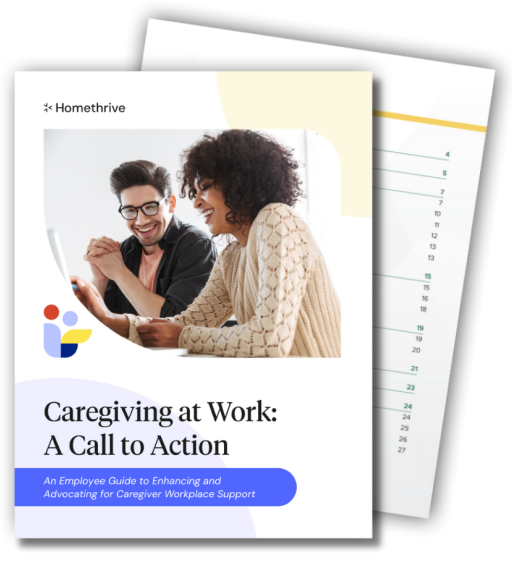Grief is a universal human experience. Unfortunately, in the workplace, it often remains unspoken and unsupported. When an employee loses a loved one, the pain lasts far beyond the immediate days of bereavement.
Employees struggle with raw emotions, fractured concentration, and daily responsibilities that can feel insurmountable. For many organizations, this grief can translate to prolonged absenteeism, presenteeism, and a decline in team morale.
Forward-thinking HR leaders are recognizing the need for comprehensive loss support programs that go beyond standard bereavement leave. Providing support in the months following a loss helps an employee recover emotionally and logistically, while strengthening organizational culture and performance. Homethrive’s Loss Support is one example of an integrated solution designed to meet these evolving needs.
The Personal Impact of Grief on Employees
Grief is deeply personal. No two employees will experience it the same way, but there are familiar patterns in how loss affects day-to-day life. Someone who was once focused and reliable may suddenly struggle to concentrate, forget simple tasks, or feel drained after just a few hours at work. Emotions can hit in unpredictable waves—sadness, irritability, or even guilt—while the body often responds with exhaustion, headaches, and sleepless nights.
Even the most dedicated employees may show up physically but feel mentally elsewhere. This “presenteeism” can last weeks or even months, quietly affecting productivity and confidence. The assumption that someone is “back to normal” after a short bereavement leave often overlooks the reality: grief is a long, uneven process that doesn’t end when a leave period does.
Understanding Presenteeism in the Wake of Grief
Presenteeism occurs when employees come to work physically present but mentally and emotionally distant. After a significant loss, many employees push themselves to return to their routines, fearing they might fall behind or be perceived as disengaged. On the surface, they are back at their desks, but inside, they are coping with fatigue, distraction, and emotional waves that can strike at any moment.
This hidden impact can quietly erode productivity. Routine tasks take longer, small mistakes become more frequent, and creative or strategic thinking suffers. Unlike absenteeism, which is visible and trackable, presenteeism often goes unnoticed until it affects deadlines, team performance, or client relationships. On average, this leads to $7.5k in productivity costs per case.
For organizations, addressing presenteeism means recognizing that grief does not end when leave does. Providing structured loss support gives employees the space and tools to heal, helping them return to work fully engaged rather than merely present.
Emotional Weight That Lingers
Grief can bring unexpected emotional shifts. A small reminder of their loss may trigger tears, frustration, anger, or anxiety, sometimes in the middle of the workday. Employees struggling with loss might withdraw from colleagues, skip team lunches, or avoid conversations to protect themselves. Without a safe, understanding work environment, these moments can become isolating and overwhelming for individuals navigating grief.
Mental and Cognitive Challenges
Grieving employees often describe their minds as “foggy.” Routine tasks take longer. Decisions feel heavier. Creativity and problem-solving—the mental energy that drives innovation—can fade. And this reality is not just for employees; 85% of managers report on impaired decision-making following a loss.
These noted challenges aren’t an employee being lazy; it’s the brain’s natural response to emotional overload.
The Physical Side of Grief
The effects of grief reach well beyond emotions. Sleepless nights, frequent colds, or even stomach issues are common when the body is under prolonged stress. Employees who are already running on empty physically will struggle to perform consistently, which can lead to unplanned absences or longer recovery times.
The Organizational Impact of Employee Grief
Grief doesn’t stay at home. When an employee experiences a significant loss, the ripple effect can be felt across an entire organization. Research from the Grief Recovery Institute estimates that U.S. businesses lose over $75 billion annually due to the impact of unaddressed grief in the workplace. These losses aren’t just about absenteeism—they show up in mistakes, lowered productivity, and eventual turnover when employees feel unsupported or unable to cope.
The Hidden Costs of Grief in the Workplace
Grieving employees may need more time to complete tasks, miss key details, or struggle with decision-making. A single misstep might create rework, while minor delays can add up to missed deadlines or project slowdowns. Over time, these hidden costs compound, quietly eroding efficiency and affecting the bottom line.
In client-facing or safety-sensitive roles, the stakes are even higher. A distracted driver, technician, or healthcare worker could inadvertently create safety risks. Similarly, an unfocused account manager or customer service professional may unintentionally harm client relationships during a vulnerable period.
The Ripple Effect on Teams
Grief doesn’t just affect the individual—it impacts the entire team. When one employee struggles, coworkers often step in to pick up extra responsibilities. While this is natural and empathetic, it can lead to fatigue and frustration if the additional workload isn’t acknowledged or supported by leadership.
Teams may also feel uncertain about how to respond to their grieving colleague. Should they reach out or give space? This discomfort can lead to awkwardness, reduced communication, and a dip in morale. Without organizational guidance or support, both the grieving employee and their peers can feel adrift.
Responding Effectively to an Employee Loss
The first days following an employee’s loss are critical. A thoughtful, well-structured response demonstrates compassion and sets the stage for long-term recovery. Organizations should aim to balance empathy with clarity, ensuring employees feel supported while minimizing unnecessary stress.
Acknowledge the Loss
Reaching out quickly with a sincere, personal message can make an enormous difference. Avoid platitudes or scripted condolences; instead, offer a simple acknowledgment and assurance of support. HR or leadership should also respect the employee’s wishes regarding privacy and internal communication.
Provide Clear Leave and Benefit Information
One of the most immediate needs is clarity around time off. Provide written guidance about bereavement leave, flexible PTO options, and remote work possibilities. Designate a single point of contact in HR to handle questions about benefits, insurance claims, or Employee Assistance Programs (EAPs), reducing the emotional burden of repeated explanations. Benefits like Homethrive’s Loss Support program also coordinate with other benefits and EAPs, providing one unified service for all loss support questions.
Adjust Workload and Set Realistic Expectations
Returning to work does not mean the employee is operating at full capacity. Managers should consider temporary adjustments, such as flexible scheduling or phased reentry. Transparent communication with team members—without breaching confidentiality—can also prevent misunderstandings about workload redistribution.
Maintain Support Beyond the First Week
While the initial outreach matters, continued follow-up is crucial. Schedule check-ins at regular intervals, such as two weeks, one month, and three months post-loss. These touchpoints allow organizations to offer additional support and remind employees of available loss support resources.
What Happens After a Loss
The reality of loss extends far beyond funeral services and the first weeks of bereavement. Employees often face months of administrative, financial, and emotional responsibilities that can weigh heavily on their mental bandwidth.
The Administrative Burden
Managing the aftermath of a death can feel like a second full-time job. Tasks often include obtaining death certificates, managing probate or estate settlements, closing bank accounts, filing insurance claims, and notifying government agencies like Social Security or the Canada Revenue Agency. Employees may also need to handle property transfers, digital account closures, and medical bill reconciliations.
Research indicates that these tasks can take 570+ hours over 9–18 months, much of which occurs during standard working hours. Without guidance or support, employees can become overwhelmed, distracted, and exhausted.
Shifting Family Roles
Loss often reshapes family dynamics overnight. An employee might suddenly become the primary caregiver for surviving relatives, take on decision-making for siblings or parents, or step into roles their loved one once managed. These new responsibilities demand time, energy, and emotional capacity—resources already stretched thin by grief.
Emotional and Cognitive Implications
Beyond the paperwork, grief persists as an emotional undercurrent. Even when employees seem “back to normal,” grief has a way of resurfacing without warning. Anniversaries, birthdays, or even a familiar song can trigger a flood of sadness or anxiety. These emotional waves can appear during meetings, calls, or quiet moments at a desk, making it hard to focus or engage fully at work.
This combination of logistical strain and emotional upheaval can be exhausting. Over time, the pressure may lead to mistakes, missed deadlines, or withdrawal from colleagues. Without structured support, employees often feel isolated and overwhelmed—and some may even consider leaving their jobs entirely.
Recognizing that grief doesn’t follow a neat timeline is key. By understanding what life looks like after the loss, organizations can better support employees through this extended and challenging season.
Why Employers Need to Acknowledge the Long Tail of Loss
By recognizing that the post-loss phase is both logistically demanding and emotionally taxing, employers can better tailor their support programs to meet real-world employee needs.
The Benefits of Loss Support: Why Employers Should Care
Grief doesn’t respect schedules, projects, or deadlines. When an employee experiences a loss, it follows them into the workplace, often quietly impacting focus, morale, and productivity. For organizations, the challenge isn’t just acknowledging that grief exists—it’s deciding how to respond with empathy and structure in a way that genuinely helps.
The truth is that healing is rarely linear. A week or two of bereavement leave does not erase the emotional or logistical demands of a loss. Without support, employees can carry this invisible weight for months, quietly eroding their confidence and performance.
Homethrive’s Loss Support offering was designed with this reality in mind. By providing resources that extend well beyond traditional bereavement leave, employers can reduce the hidden costs of grief and reinforce a culture of care.
Organizations that offer resources, flexibility, and structured loss support programs help employees rebuild resilience, signaling: we see you, and we value your well-being.
How Loss Support Programs Help
Traditional bereavement leave is a short-term solution for a long-term challenge. Loss support programs fill the gap, helping employees navigate both the emotional and practical aspects of loss with confidence.
Homethrive’s Loss Support provides:
Hands-on task completion: we create and execute personalized action plans—directly handling emotionally draining tasks from funeral arrangements and estate paperwork to probate navigation and benefit claims.
Compassionate emotional care: Care Guides who understand grief provide 1:1 support and connect employees directly to specialized therapists, support groups, and experts tailored to their specific needs.
Dedicated advocacy: we proactively liaise with legal, financial, and estate professionals, cutting through red tape so employees don’t have to.
Secure & intuitive digital tools: complementing human support, our integrated platform securely organizes essential documents and provides 24/7 access to Care Guide-vetted resources.
In total, Homethrive saves your employees up to 200 hours of time they’d otherwise spend navigating paperwork, phone calls, and complex processes—so they can regain their footing faster and focus on what matters, not logistics. By reducing the mental load of post-loss logistics, these programs allow employees to focus on healing, re-engagement, and productivity. Organizations benefit from fewer errors, less absenteeism, and stronger employee loyalty.
Why Employers Should Invest in Loss Support
Supporting employees after a loss is more than a gesture of goodwill—it’s a measurable business advantage.
Protecting Employee Well-Being
Employees who feel genuinely supported during a life-altering event are more likely to remain engaged and loyal. That sense of psychological safety deepens trust in leadership and fosters a positive work environment.
Safeguarding Productivity and Retention
Presenteeism, absenteeism, and turnover are costly. With 80% of younger employees considering leaving their roles without proper supports in place, investing in loss support allows organizations to protect productivity while retaining valuable talent.
Strengthening Culture and Employer Brand
A culture of empathy is a competitive differentiator. Companies that demonstrate care for employees through all stages of life strengthen their employer brand and reinforce diversity, equity, and inclusion efforts.
Minimizing Risk and Disruption
In safety-sensitive or client-facing industries, errors can carry serious consequences. Structured support ensures employees return to work with clarity, reducing risk to both people and operations.
Investing in loss programs like Homethrive’s is a clear signal that your organization values its people—not just when they’re thriving, but when they’re facing life’s most challenging moments.
Conclusion
Grief is an unavoidable part of life, and its impact on the workplace is both profound and long-lasting. While the initial days after a loss often receive attention through bereavement leave or brief gestures of support, the reality is that employees continue to carry the weight of their loss for weeks and even months. Ignoring this “long tail” of grief can quietly erode productivity, increase turnover, and strain team dynamics, while also leaving employees feeling isolated and unsupported.
By acknowledging the full scope of loss—emotional, cognitive, and administrative—organizations have the opportunity to transform a moment of vulnerability into one of trust and connection. Structured loss support programs do more than help employees cope; they protect organizational health, reinforce company culture, and strengthen the bond between leadership and staff.
Programs like Homethrive’s Loss Support provide a compassionate framework for guiding employees through estate and financial responsibilities, offering emotional resources, and maintaining regular check-ins to ensure recovery is sustainable. This type of proactive investment communicates a clear message: your people matter, not just when they’re productive, but when they’re navigating life’s most challenging moments.
By partnering with Homethrive, you can help employees reclaim valuable time and energy to focus on their work, families, and personal well-being.
Show your team they don’t have to choose between their careers and caregiving responsibilities. Contact us today to explore how Homethrive can enhance your employees’ well-being and productivity.







